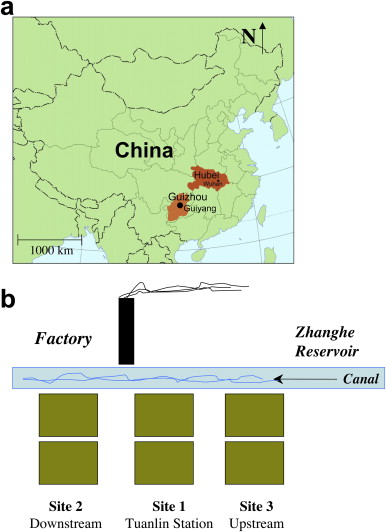
Figure a) Map of China, including Hubei province and Guizhou province; b) orientation for sites 1–3 in Hubei province, 2 paddies in each site. A constructed wetland bordered the rice paddies in site 2.
In China, total Hg (Hg-T) and methylmercury (MeHg) were quantified in rice grain grown in three sites using water-saving rice cultivation methods, and in one Hg-contaminated site, where rice was grown under flooded conditions. Polished white rice concentrations of Hg-T (water-saving: 3.3 +/- 1.6 ng/g; flooded: 110 +/- 9.2 ng/g) and MeHg (water-saving 1.3 +/- 0.56 ng/g; flooded: 12 +/- 2.4 ng/g) were positively correlated with root-soil HgT and MeHg contents (HgT: r(2) = 0.97, MeHg: r(2) = 0.87, p < 0.05 for both), which suggested a portion of Hg species in rice grain was derived from the soil, and translocation of Hg species from soil to rice grain was independent of irrigation practices and Hg levels, although other factors may be important. Concentrations of HgT and other trace elements were significantly higher in unmilled brown rice (p<0.05), while MeHg content was similar (p > 0.20), indicating MeHg infiltrated the endosperm (i.e., white rice) more efficiently than inorganic Hg(II). (C) 2011 Elsevier Ltd. All rights reserved.
| Publication name |
ENVIRONMENTAL POLLUTION Volume: 159 Issue: 5 Special Issue: Sp. Iss. SI Pages: 1283-1289 Published: MAY 2011 |
| Author(s) |
Rothenberg, Sarah E.; Feng, Xinbin; Dong, Bin; Shang, Lihai; Yin, Runsheng; Yuan, Xiaobo |
| Corresponding author |
Rothenberg, Sarah E
rothenberg.sarah@gmail.com
Chinese Acad Sci, Inst Geochem, State Key Lab Environm Geochem, 46 Guanshui Lu, Guiyang 550002, Peoples R China |